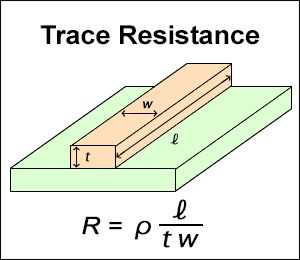PCB Trace Voltage Drop & Temperature Rise Calculator
Evaluate resistance, voltage drop, power loss and temperature rise of power traces/bus bars
Inputs
A
°C
W/m²·K
Results
Copper cross-section A-- mm²
Resistance R@20°C-- mΩ
Resistance R@operating-- mΩ
Voltage drop ΔV = I×R-- mV
Power loss P = I²×R-- W
Current density J-- A/mm²
Temperature rise ΔT-- °C
Operating temperature Tₒ-- °C

Illustration: trace length, width and thickness definitions
Principles & Example
At 10 A, if total trace resistance is 50 mΩ, the drop is about 0.5 V on the supply rail alone. If the ground return uses a similar narrow trace instead of a plane, the total drop may be nearly twice.
Equations: R = ρ × L / (W × T) with copper temperature coefficient α≈0.00393/°C; ΔV = I × R; P = I² × R. Temperature rise via simplified Newton cooling P ≈ h × Asurf × ΔT with Asurf ≈ L × (W + 2T) (top and sides only).
- 1 oz ≈ 35 μm; unit selector supports oz/mm/mil/μm.
- Typical natural convection h ≈ 8–12 W/m²·K.
- Use IPC-2152, simulation or measurement for accurate thermal results.